A Predictive Cabin Conditioning Strategy for Battery Electric Vehicles
Abstract
1. Introduction
2. Fundamentals of the Model Predictive Control Approach
3. Realization of the MPC Control Strategy in a Model-in-the-Loop (MiL) Environment
3.1. Structure of the MiL Environment
3.2. Modelling of the System Dynamics—Cabin Conditioning
4. Investigations to Determine the Effectiveness of the MPC Approach
4.1. Description of the Rule-Based Control Strategy (RB) Used as the Basis for the Assessment
4.2. Simulation Results at Cold Ambient Conditions
4.3. Simulation Results at Hot Ambient Conditions
5. Summary and Outlook
Author Contributions
Funding
Data Availability Statement
Conflicts of Interest
References
- Bundesministerium für Wirtschaft und Klimaschutz: Abkommen von Paris. Available online: https://www.bmwk.de/Redaktion/DE/Artikel/Industrie/klimaschutz-abkommen-von-paris.html (accessed on 29 February 2024).
- Europäische Kommission. Umsetzung des europäischen Grünen Deals: Auf dem Weg zu einem Klimaneutralen Europa bis 2050. Available online: https://commission.europa.eu/strategy-and-policy/priorities-2019-2024/european-green-deal/delivering-european-green-deal_de (accessed on 29 February 2024).
- Bundesregierung. Klimaschutzgesetz: Generationenvertrag für das Klima. 7 November 2022. Available online: https://www.bundesregierung.de/breg-de/schwerpunkte/klimaschutz/klimaschutzgesetz-2021-1913672 (accessed on 29 February 2024).
- Europäische Kommission. Special Eurobarometer 513—Climate Change: Report. Available online: https://ec.europa.eu/clima/system/files/2021-07/report_2021_en.pdf (accessed on 29 February 2024).
- Europäische Kommission. Mitteilung der Kommission an das Europäische Parlament, den Rat, den Europäischen Wirtschafts-und Sozialausschuss und den Ausschuss der Regionen: „Fit für 55“: Auf dem Weg zur Klimaneutralität—Umsetzung des EU-Klimaziels für 2030. Available online: https://eur-lex.europa.eu/legal-content/DE/TXT/PDF/?uri=CELEX:52021DC0550&from=DE (accessed on 29 February 2024).
- Bundesregierung. Nachhaltige Mobilität: Nicht Weniger Fortbewegen, Sondern Anders. 23 December 2022. Available online: https://www.bundesregierung.de/breg-de/schwerpunkte/klimaschutz/nachhaltige-mobilitaet-2044132 (accessed on 29 February 2024).
- European Environment Agency. New Registrations of Electric Vehicles in Europe. Available online: https://www.eea.europa.eu/ims/new-registrations-of-electric-vehicles (accessed on 29 February 2024).
- Götz, K.; Sunderer, G.; Birzle-Harder, B.; Deffner, J. Attraktivität und Akzeptanz von Elektroautos: Ergebnisse aus dem Projekt OPTUM. Optimierung der Umweltentlastungspotenziale von Elektrofahrzeugen; ISOE: Frankfurt am Main, Germany, 2012. [Google Scholar]
- Tschöke, H.; Gutzmer, P.; Pfund, T. Elektrifizierung des Antriebsstrangs: Grundlagen—Vom Mikro-Hybrid zum vollelektrischen Antrieb; ATZ/MTZ-Fachbuch; Springer: Berlin/Heidelberg, Germany, 2019. [Google Scholar]
- Hemkemeyer, D. Thermomanagement im Elektrischen Personenkraftwagen unter Nutzung der Abwärme des Antriebs. Ph.D. Thesis, RWTH Aachen University, Aachen, Germany, 9 October 2017. [Google Scholar]
- Beetz, K.; Kohle, U.; Eberspach, G. Beheizungskonzepte für Fahrzeuge mit Alternativen Antrieben. ATZ Automob. Z. 2010, 112, 246–249. [Google Scholar] [CrossRef]
- Allgemeiner Deutscher Automobil-Club E.V. Stromverbrauch von Sitzheizung und Co: Wie Hoch ist er Tatsächlich? Available online: https://www.adac.de/rund-ums-fahrzeug/ausstattung-technik-zubehoer/ausstattung/sitzheizung-verbrauch/ (accessed on 29 February 2024).
- Rudschies, W. Elektroauto im Winter: So wirkt sich Kälte auf Verbrauch und Reichweite aus. Available online: https://www.adac.de/rund-ums-fahrzeug/elektromobilitaet/info/elektroauto-reichweite-winter/ (accessed on 29 February 2024).
- Auer, M. Ein Beitrag zur Erhöhung der Reichweite eines Batterieelektrischen Fahrzeugs durch Prädiktives Thermomanagement; Springer: Wiesbaden, Germany, 2016. [Google Scholar]
- VDI und VDE. Brennstoffzellen- und Batteriefahrzeuge: Bedeutung für die Elektromobilität. Last Updated: 7 June 2019. Available online: https://www.vdi.de/ueber-uns/presse/publikationen/details/brennstoffzellen-und-batteriefahrzeuge (accessed on 27 April 2022).
- Chen, Y.; Kwak, K.H.; Kim, J.; Kim, Y.; Jung, D. Energy-efficient cabin climate control of electric vehicles using linear time-varying model predictive control. Optim. Control Appl. Methods 2023, 44, 773–797. [Google Scholar] [CrossRef]
- Wang, H.; Meng, Y.; Zhang, Q.; Amini, M.R.; Kolmanovsky, I.; Sun, J.; Jennings, M. MPC-based Precision Cooling Strategy (PCS) for Efficient Thermal Management of Automotive Air Conditioning System. In Proceedings of the 2019 IEEE Conference on Control Technology and Applications (CCTA), Hong Kong, China, 19–21 August 2019; pp. 573–578. [Google Scholar]
- Liu, Y.; Zhang, J. Electric Vehicle Battery Thermal and Cabin Climate Management Based on Model Predictive Control. J. Mech. Des. 2021, 143, 031705. [Google Scholar] [CrossRef]
- Manns, P.; Hemkemeyer, D.; Linse, D. Predictive Cabin Climatization for Electric Vehicles. ATZ Worldw. 2022, 124, 36–39. [Google Scholar] [CrossRef]
- Schutzeich, P.; Pischinger, S.; Hemkemeyer, D.; Wahl, A.; Franke, K. A Model Predictive Control Strategy for Advanced Passenger Compartment Air Conditioning in Vehicles with Electrified Powertrains. In Proceedings of the 2022 SAE Thermal Management Systems Symposium, Plymouth, MI, USA, 4–5 October 2022. [Google Scholar]
- Schaut, S.; Sawodny, O. Thermal Management for the Cabin of a Battery Electric Vehicle Considering Passengers’ Comfort. IEEE Trans. Control Syst. Technol. 2020, 28, 1476–1492. [Google Scholar] [CrossRef]
- Verschueren, R.; Frison, G.; Kouzoupis, D.; Frey, J.; Van Duijkeren, N.; Zanelli, A.; Novoselnik, B.; Albin, T.; Quirynen, R.; Diehl, M. acados—A modular open-source framework for fast embedded optimal control. Math. Program. Comput. 2022, 14, 147–183. [Google Scholar] [CrossRef]
- Systems Control And Optimization Laboratory. acados—Documentation. Last Updated: 2 January 2024. Available online: https://docs.acados.org/ (accessed on 29 February 2024).
- Systems Control And Optimization Laboratory. acados—Embedded Workflow. Available online: https://docs.acados.org/embedded_workflow/index.html (accessed on 29 February 2024).
- Cevolver Project Consortium. CEVOLVER: Connected Electric Vehicle Optimized for Life, Value, Efficiency and Range. Available online: https://cevolver.eu/ (accessed on 29 February 2024).
- Cevolver Project Consortium. Integrated Energy & Thermal Management Validator: Poster. Available online: https://cevolver.eu/wp-content/uploads/2022/10/CEVOLVER_Poster_Validator1_FINAL.pdf (accessed on 29 February 2024).
- Schutzeich, P.; Wahl, A. CEVOLVER—Thermal Management Improvements: Poster. Available online: https://cevolver.eu/wp-content/uploads/2022/10/CEVOLVER_Final_Event_Poster_Thermal_Management_FINAL.pdf (accessed on 29 February 2024).
- Wahl, A.; Schutzeich, P. CEVOLVER—Advanced Thermal Management: An Enabler of Long Distance Capabilities? Available online: https://cevolver.eu/wp-content/uploads/2022/10/Thermal_Management_in_CEVOLVER_Final_Event_V8_compressed.pdf (accessed on 29 February 2024).
- Schutzeich, P.; Hemkemeyer, D.; Franke, K.; Hamelbeck, P. A Predictive Cabin Conditioning Strategy for Battery Electric Vehicles. 36th International Electric Vehicle Symposium and Exhibition (EVS36). Available online: https://evs36.com/wp-content/uploads/finalpapers/FinalPaper_Schutzeich_Patrick.pdf (accessed on 13 December 2023).
- Papageorgiou, M.; Leibold, M.; Buss, M. Optimierung: Statische, Dynamische, Stochastische Verfahren für die Anwendung; Springer: Berlin/Heidelberg, Germany, 2015; pp. 343–427. [Google Scholar]
- Adamy, J. Nichtlineare Systeme und Regelungen; Springer: Berlin/Heidelberg, Germany, 2018; pp. 227–280. [Google Scholar]
- Schwarzkopf, S. Echtzeitfähige Optimierungsbasierte Regelung von Stofftrennprozessen. Magdeburg, Otto-von-Guericke-Universität Magdeburg, Fakultät fur Elektrotechnik und Informationstechnik. Dissertation. 16 October 2012. Available online: https://d-nb.info/1054135266/34 (accessed on 24 January 2023).
- Völz, A. Modellprädiktive Regelung Nichtlinearer Systeme mit Unsicherheiten; Springer: Wiesbaden, Germany, 2016. [Google Scholar]
- Diehl, M.; Bock, H.G.; Schlöder, J.P. A Real-Time Iteration Scheme for Nonlinear Optimization in Optimal Feedback Control. SIAM J. Control Optim. 2005, 43, 1714–1736. [Google Scholar] [CrossRef]
- Graichen, K. Methoden der Optimierung und optimalen Steuerung: Skriptum (Wintersemester 2012/2013). Last Updated: 5 August 2019. Available online: https://vdocuments.site/skriptum-methoden-der-optimierung-und-optimalen-steuerung-c-prof-dr-ing.html?page=1 (accessed on 25 January 2023).
- Wahl, A.; Wellmann, C.; Krautwig, B.; Manns, P.; Chen, B.; Schernus, C.; Andert, J. Efficiency Increase through Model Predictive Thermal Control of Electric Vehicle Powertrains. Energies 2022, 15, 1476. [Google Scholar] [CrossRef]
- Danca, P.; Bode, F.; Nastase, I.; Meslem, A. CFD simulation of a cabin thermal environment with and without human body—Thermal comfort evaluation. E3S Web Conf. 2018, 32, 1018. [Google Scholar] [CrossRef]
- Chang, T.-B.; Sheu, J.-J.; Huang, J.-W.; Lin, Y.-S.; Chang, C.-C. Development of a CFD model for simulating vehicle cabin indoor air quality. Transp. Res. Part D Transp. Environ. 2018, 62, 433–440. [Google Scholar] [CrossRef]
- Pathuri, R.; Patil, Y.; Nagarhalli, P.V. Deployment of 1D Simulation with Multi Air Zone Cabin Model for Air Conditioning System Development for Passenger Car. SAE Technical Paper Series. In Proceedings of the Symposium on International Automotive Technology 2015, Warrendale, PA, USA, 21–24 January 2015. [Google Scholar]
- Poovendran, K.; Abel, D.; Reuscher, T.; Govender, V. Vehicle Cabin Thermal Multi-Zone Modelling for Control. In Proceedings of the 2020 2nd International Conference on Control Systems, Mathematical Modeling, Automation and Energy Efficiency (SUMMA), Lipetsk, Russia, 11–13 November 2020; pp. 489–495. [Google Scholar]
- Angelova, R.A.; Markov, D.G.; Simova, I.; Velichkova, R.; Stankov, P. Accumulation of metabolic carbon dioxide (CO2) in a vehicle cabin. IOP Conf. Ser. Mater. Sci. Eng. 2019, 664, 12010. [Google Scholar] [CrossRef]
- Großmann, H.; Böttcher, C. Pkw-Klimatisierung: Physikalische Grundlagen und Technische Umsetzung; Springer: Berlin/Heidelberg, Germany, 2020. [Google Scholar]
- Lucas, K. Thermodynamik; Springer: Berlin/Heidelberg, Germany, 2008. [Google Scholar]
- Kretzschmar, H.-J.; Wagner, W. D2.1 Thermophysikalische Stoffwerte von Wasser. In VDI-Wärmeatlas; Stephan, P., Kabelac, S., Kind, M., Mewes, D., Schaber, K., Wetzel, T., Eds.; Springer: Berlin/Heidelberg, Germany, 2019; pp. 201–218. [Google Scholar]
- Ingenieure, V.D. VDI-Wärmeatlas; Springer: Berlin/Heidelberg, Germany, 2013. [Google Scholar]
- Leriche, M.; Roessner, W.; Reister, H.; Weigand, B. Numerical Investigation of Droplets Condensation on a Windshield: Prediction of Fogging Behavior. SAE Technical Paper Series. In Proceedings of the SAE 2015 World Congress & Exhibition, Detroit, MI, USA, 21–23 April 2015. [Google Scholar]
- DIN EN ISO 14505-2:2007-04; Ergonomie der Thermischen Umgebung_-Beurteilung der Thermischen Umgebung in Fahrzeugen_-Teil_2: Bestimmung der Äquivalenttemperatur (ISO_14505-2:2006); German Version EN_ISO_14505-2:2006. ISO: Geneva, Switzerland, 2007.
- Ye, G.; Yang, C.; Chen, Y.; Li, Y. A new approach for measuring predicted mean vote (PMV) and standard effective temperature (SET∗). Build. Environ. 2003, 38, 33–44. [Google Scholar] [CrossRef]
- Shaw, E.W. Thermal Comfort: Analysis and applications in environmental engineering, by P. O. Fanger. 244 pp. DANISH TECHNICAL PRESS. Copenhagen, Denmark, 1970. Danish Kr. 76, 50. R. Soc. Health J. 1972, 92, 164. [Google Scholar] [CrossRef]
- ANSI/ASHRAE Standard 55-2023; Thermal Environmental Conditions for Human Occupancy. American Society of Heating, Refrigerating and Air-Conditioning Engineers, Inc., American National Standards Institute: Peachtree Corners, GA, USA, 2023.
- Arndt, M.; Sauer, M.; Wolz, M. Verbrauchssenkung durch verbesserte Klimaanlagen-Regelung. ATZ Automob. Z. 2017, 109, 404–410. [Google Scholar] [CrossRef]
- Zhang, X.; Wargocki, P.; Lian, Z.; Thyregod, C. Effects of exposure to carbon dioxide and bioeffluents on perceived air quality, self-assessed acute health symptoms, and cognitive performance. Indoor Air 2017, 27, 47–64. [Google Scholar] [CrossRef] [PubMed]
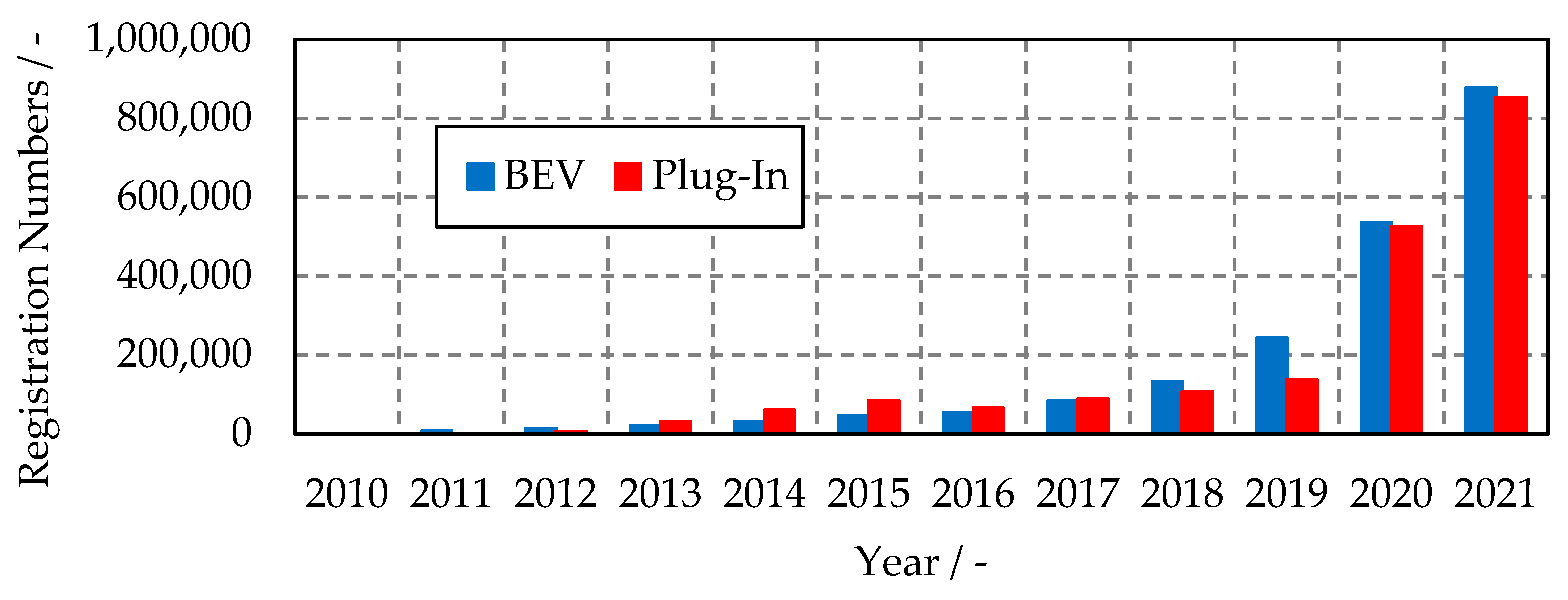

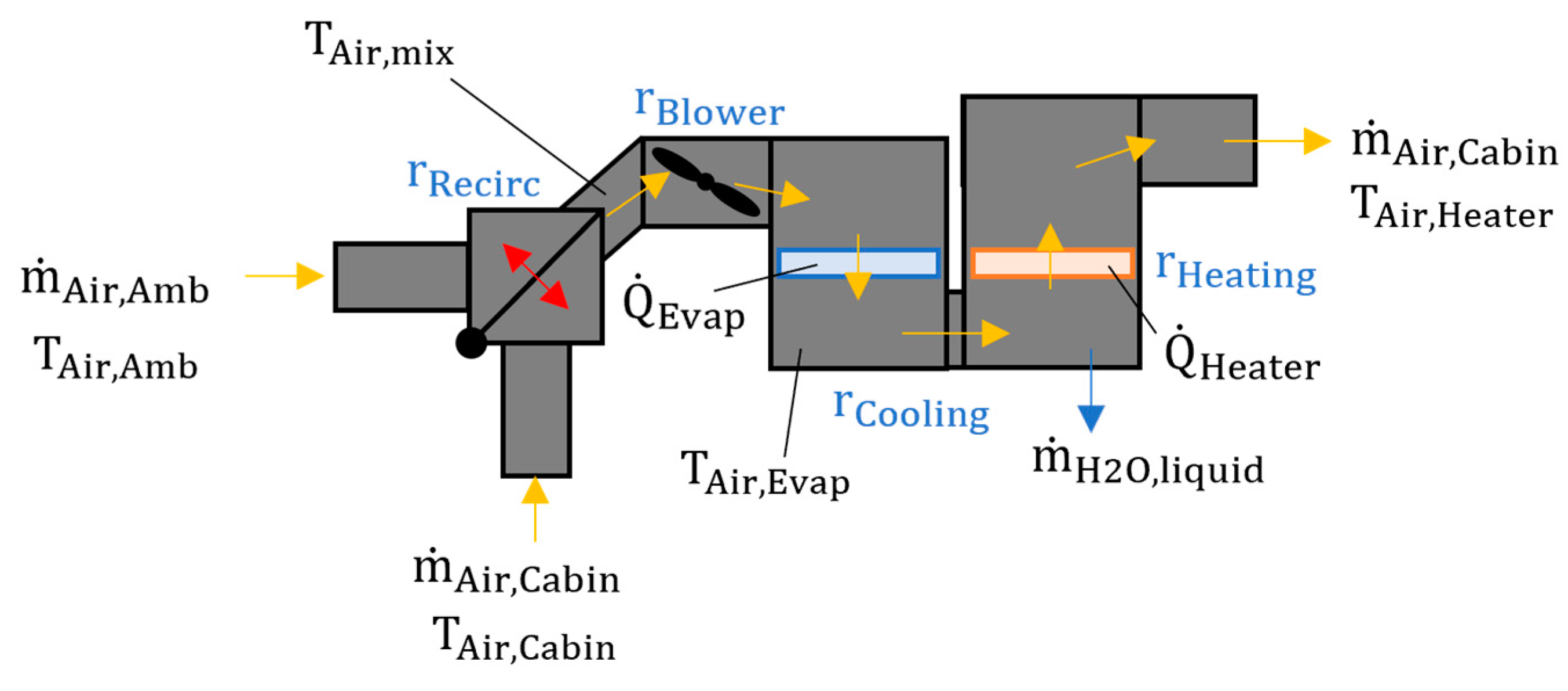
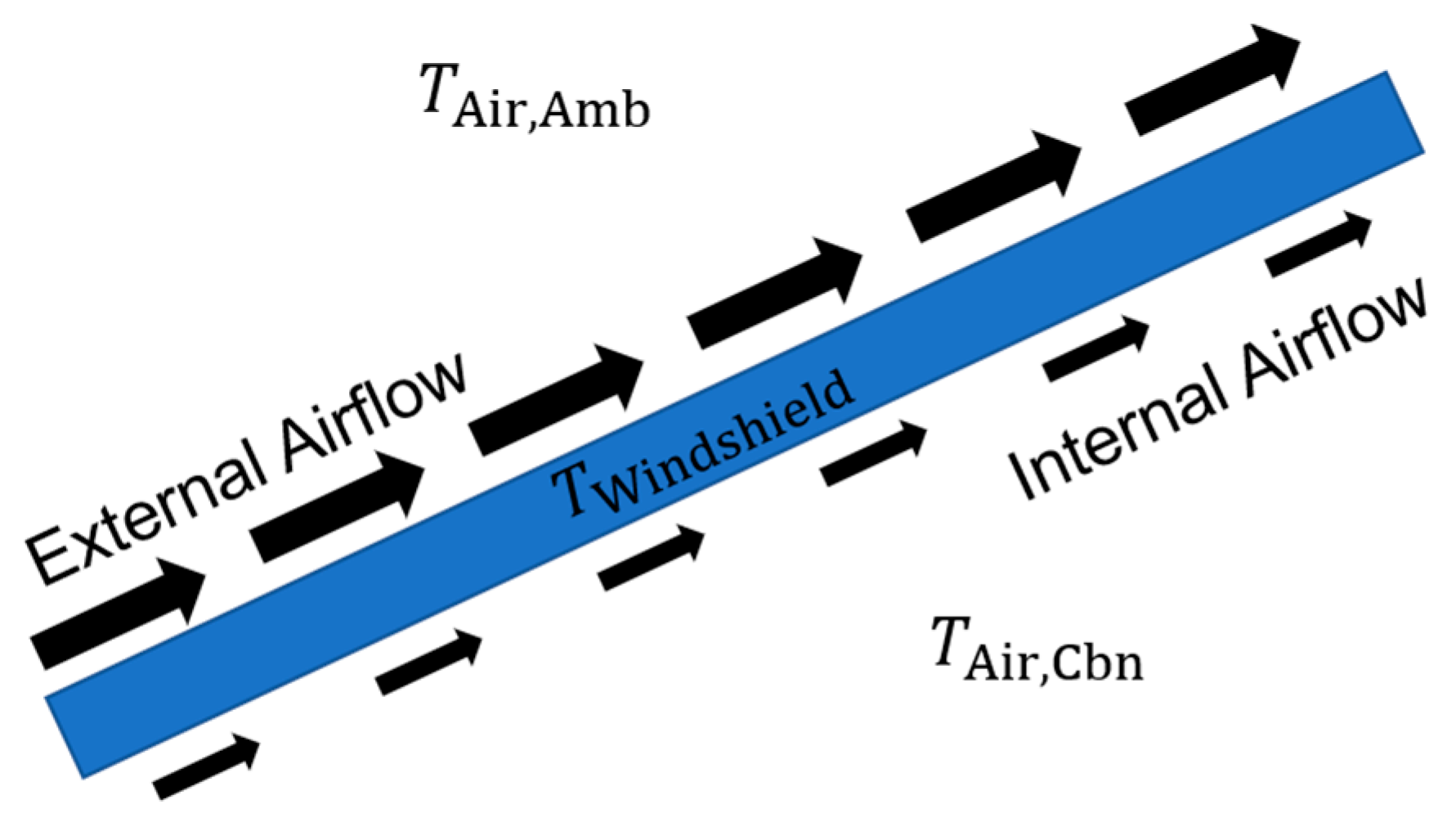
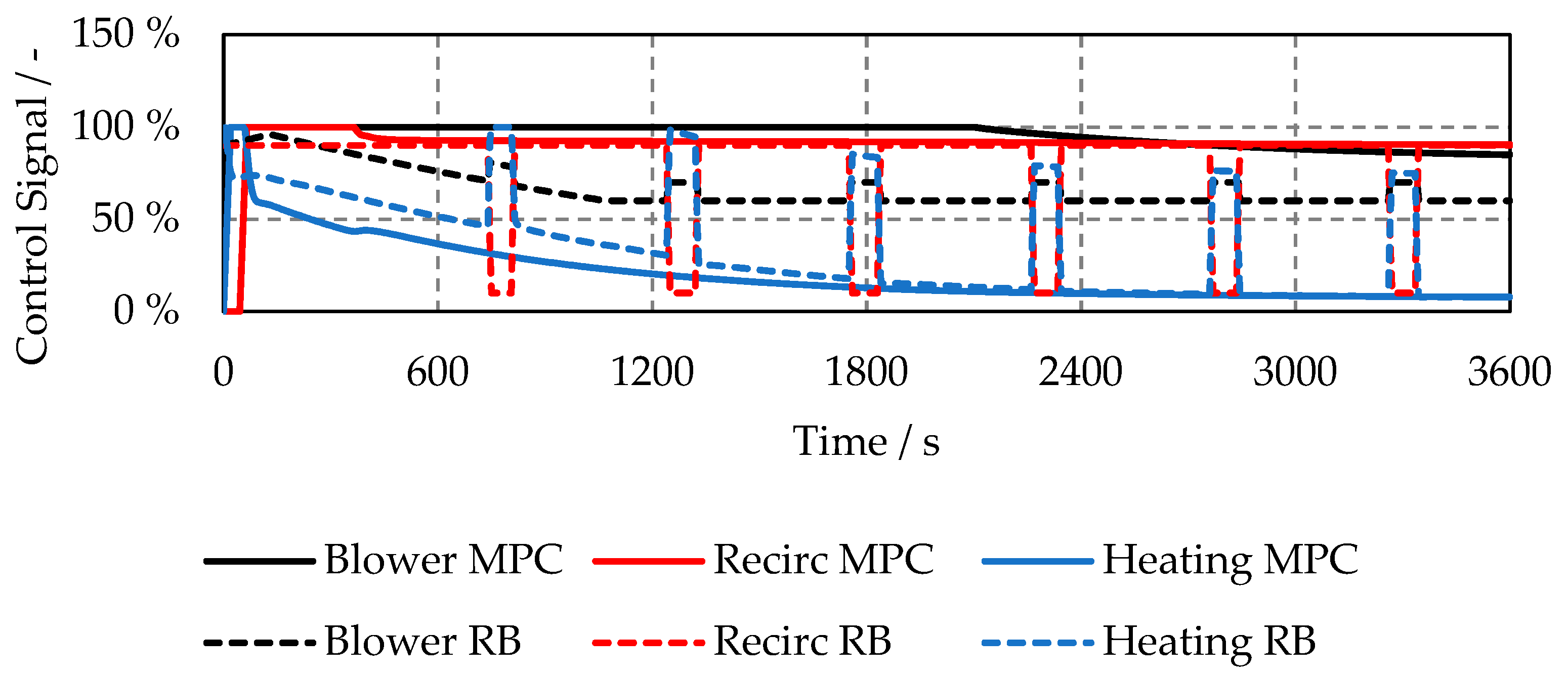
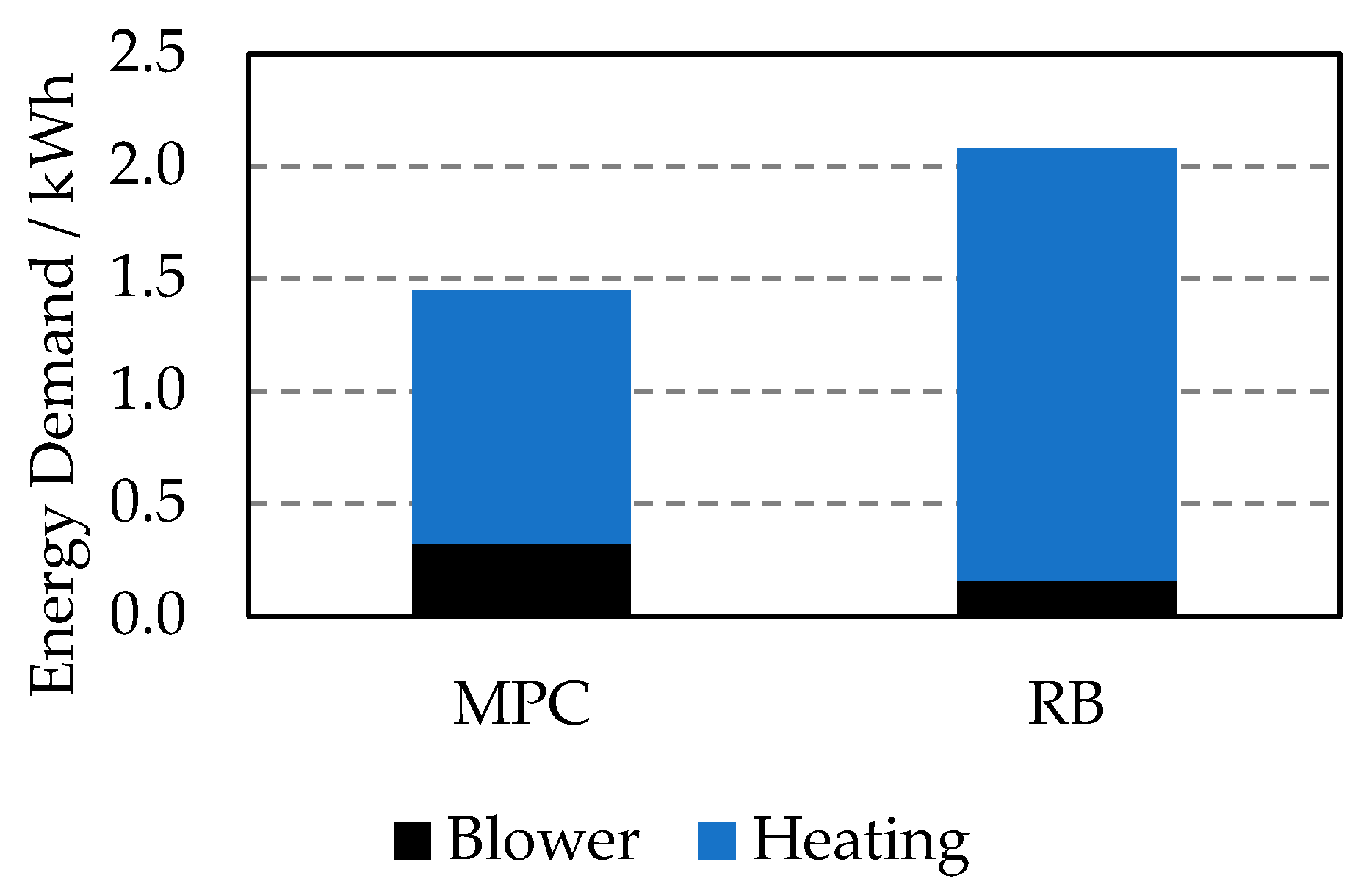
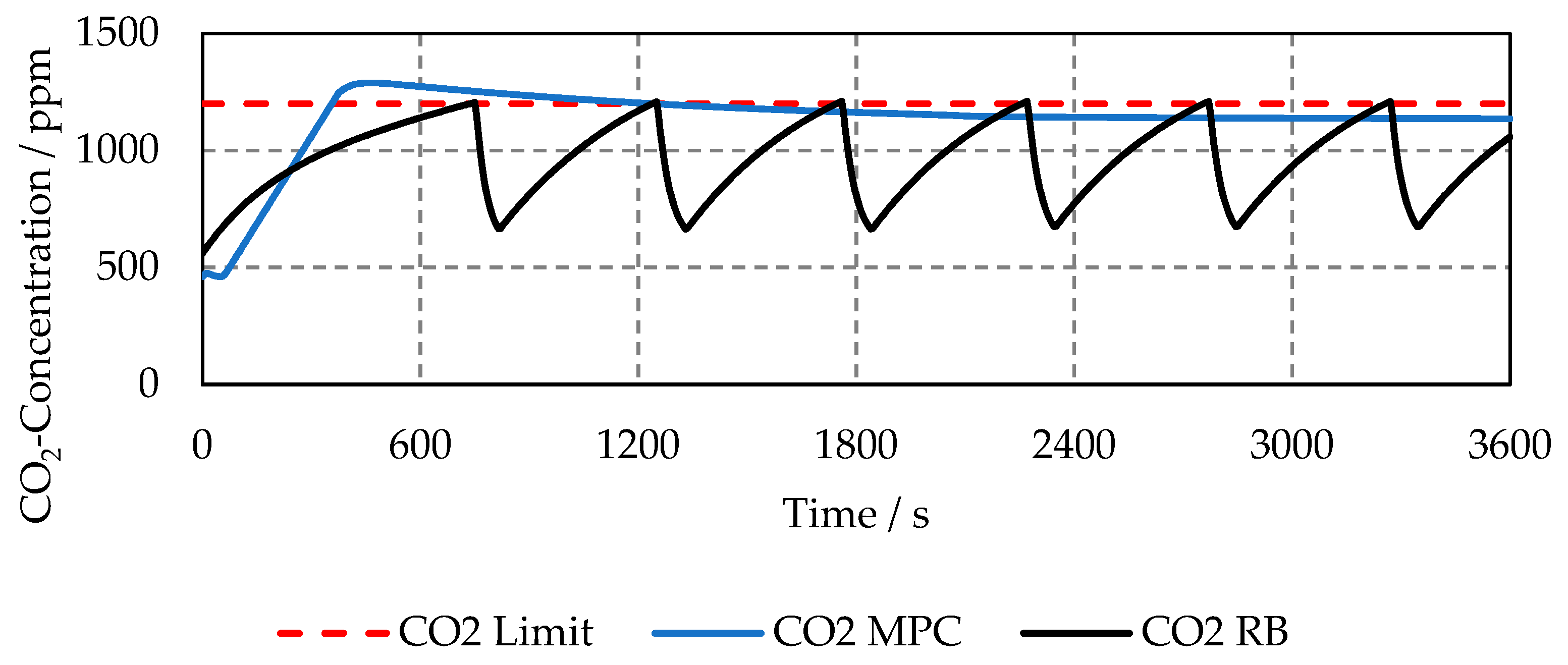
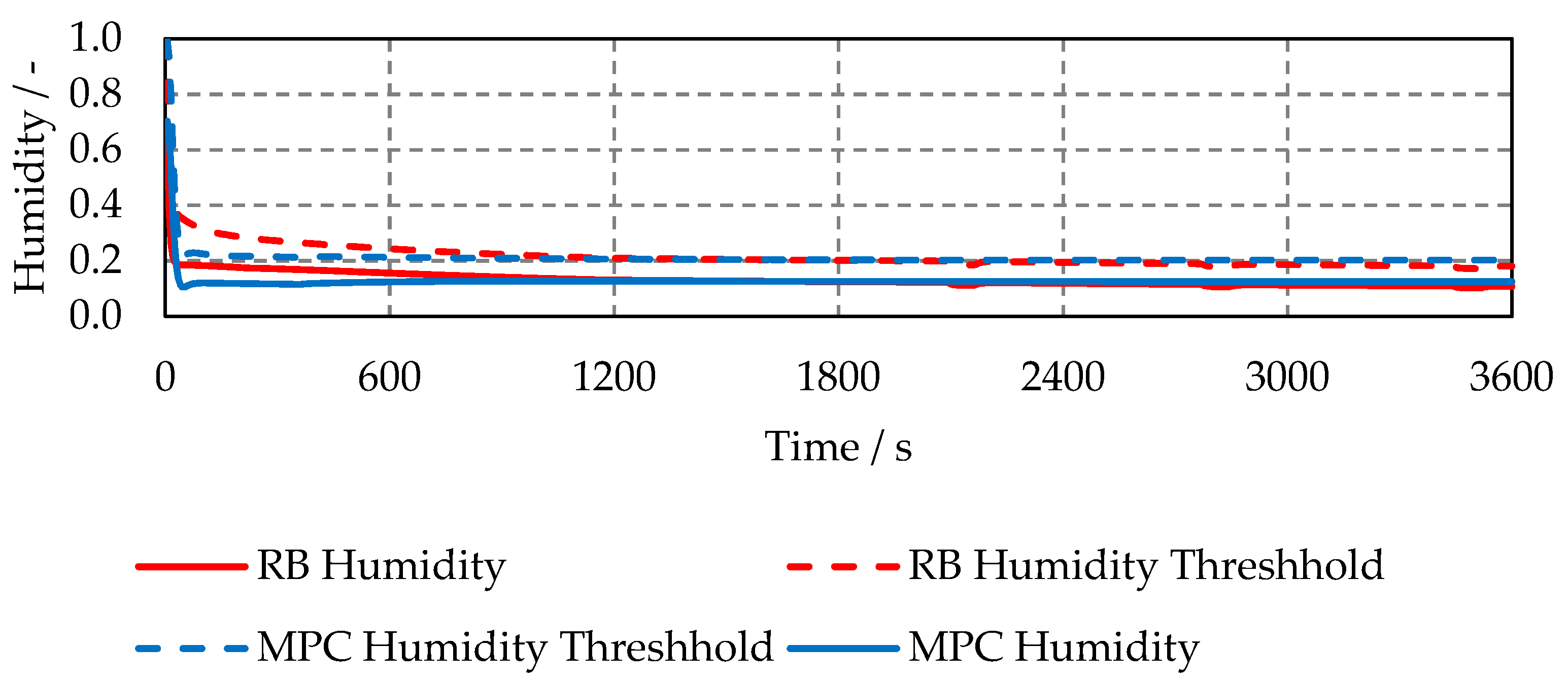
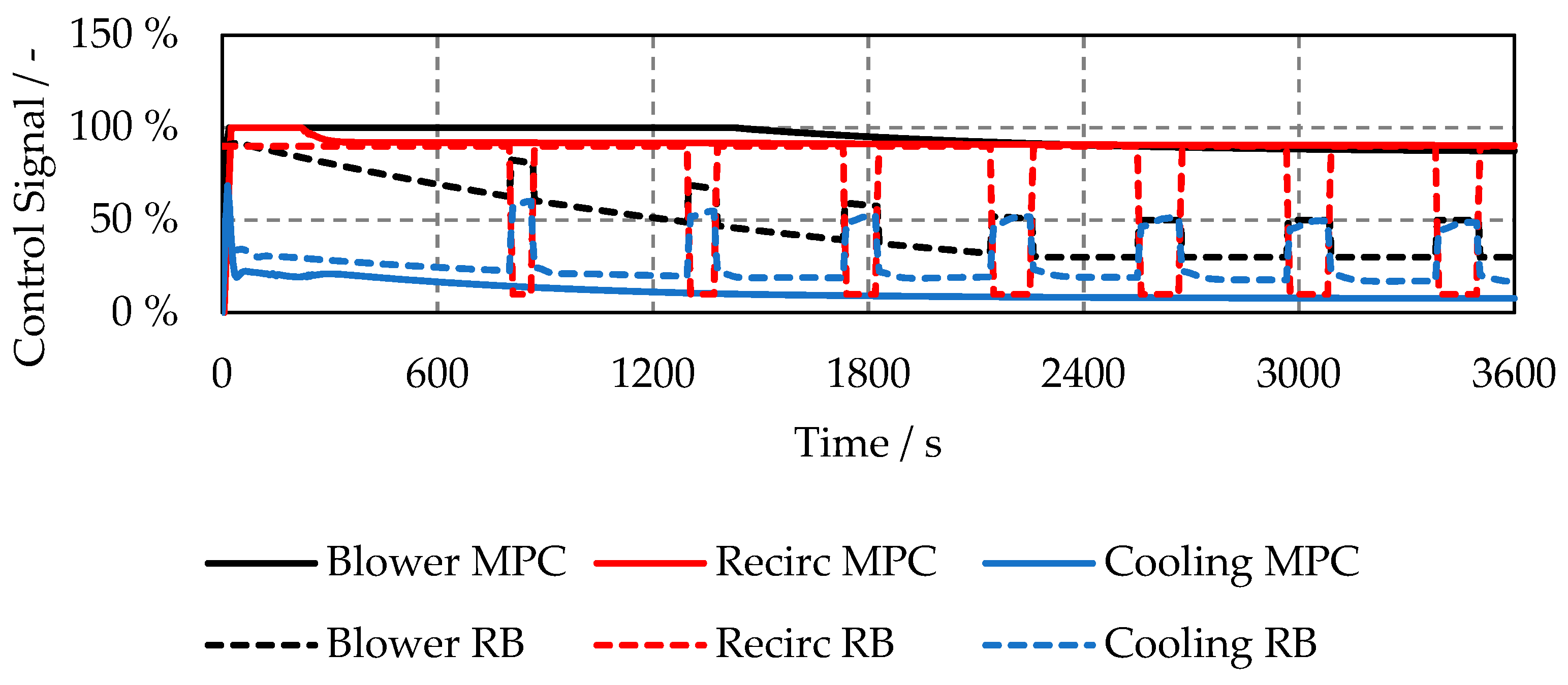
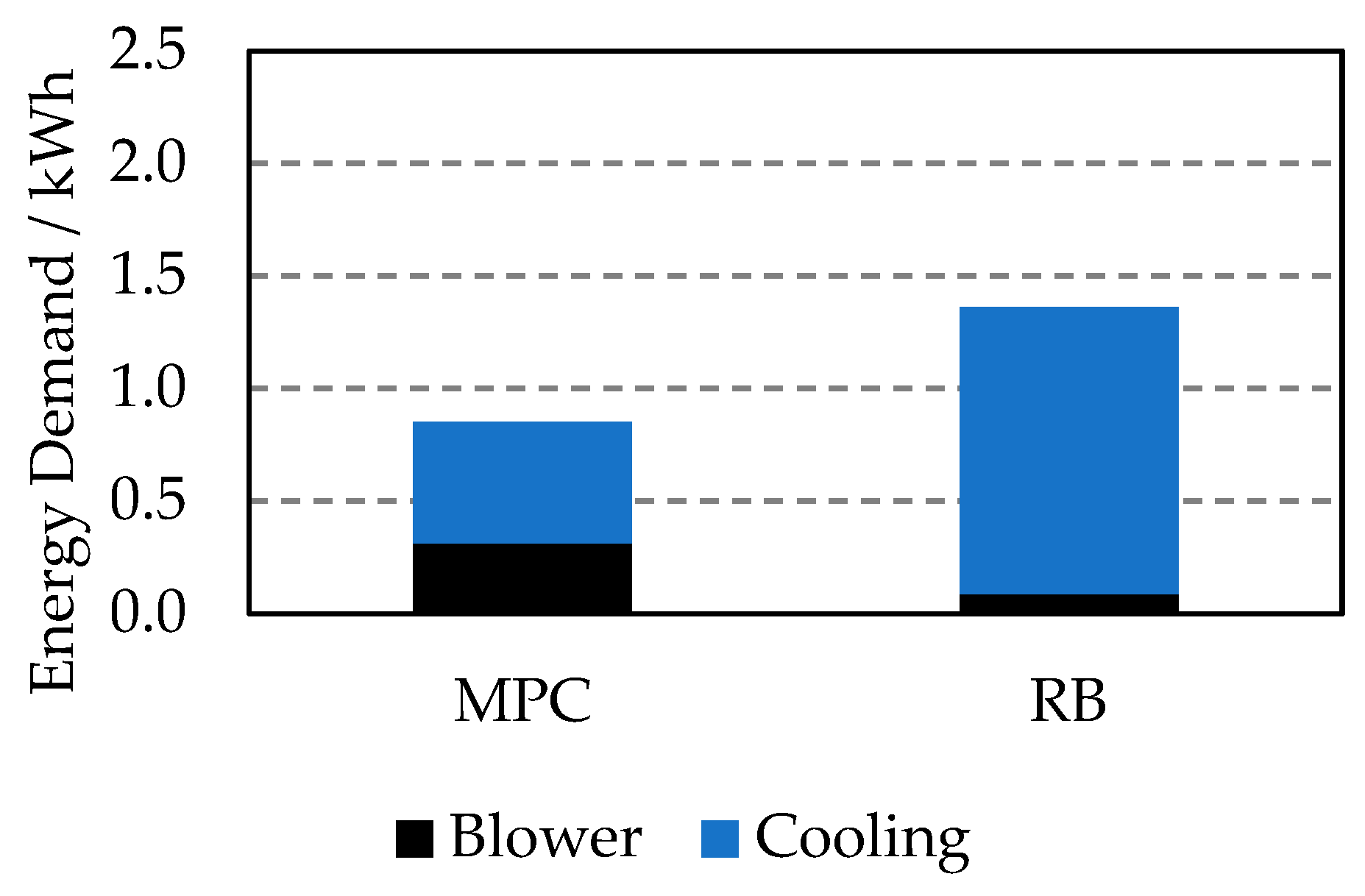
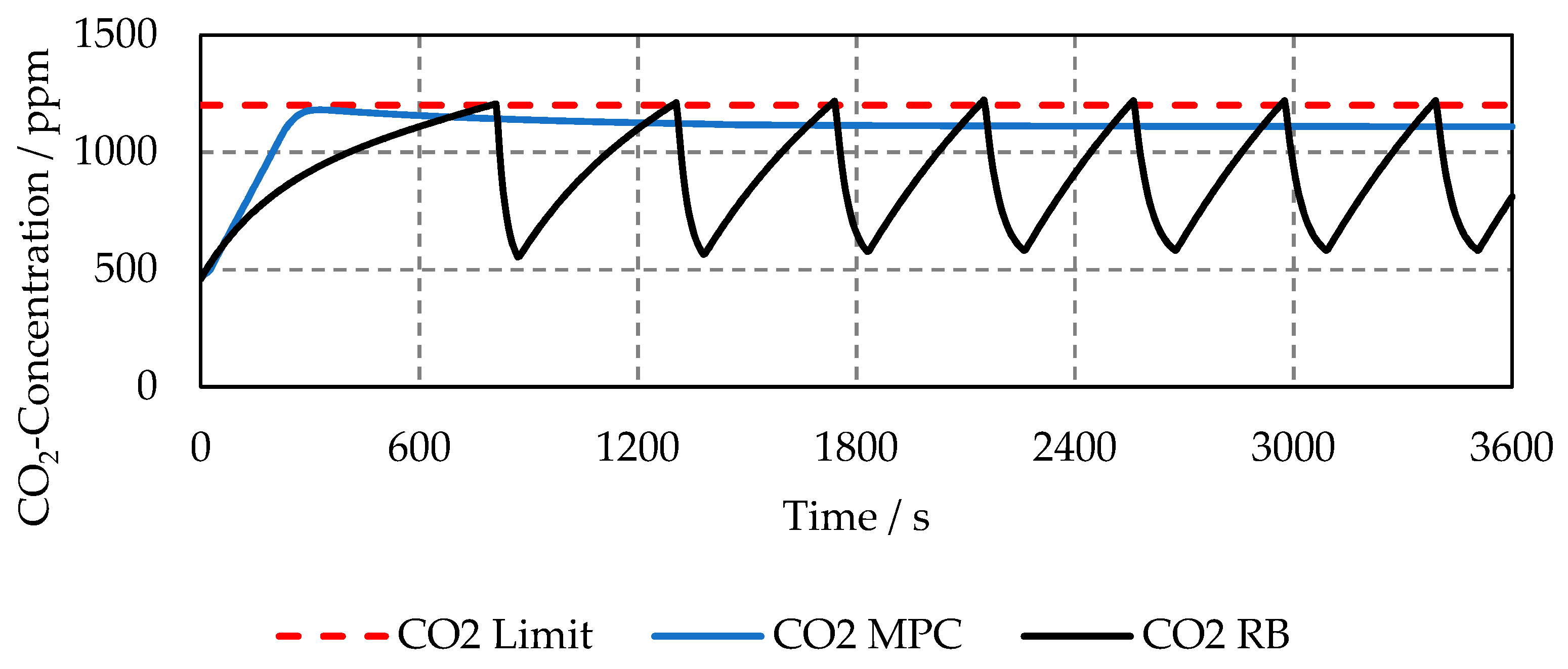
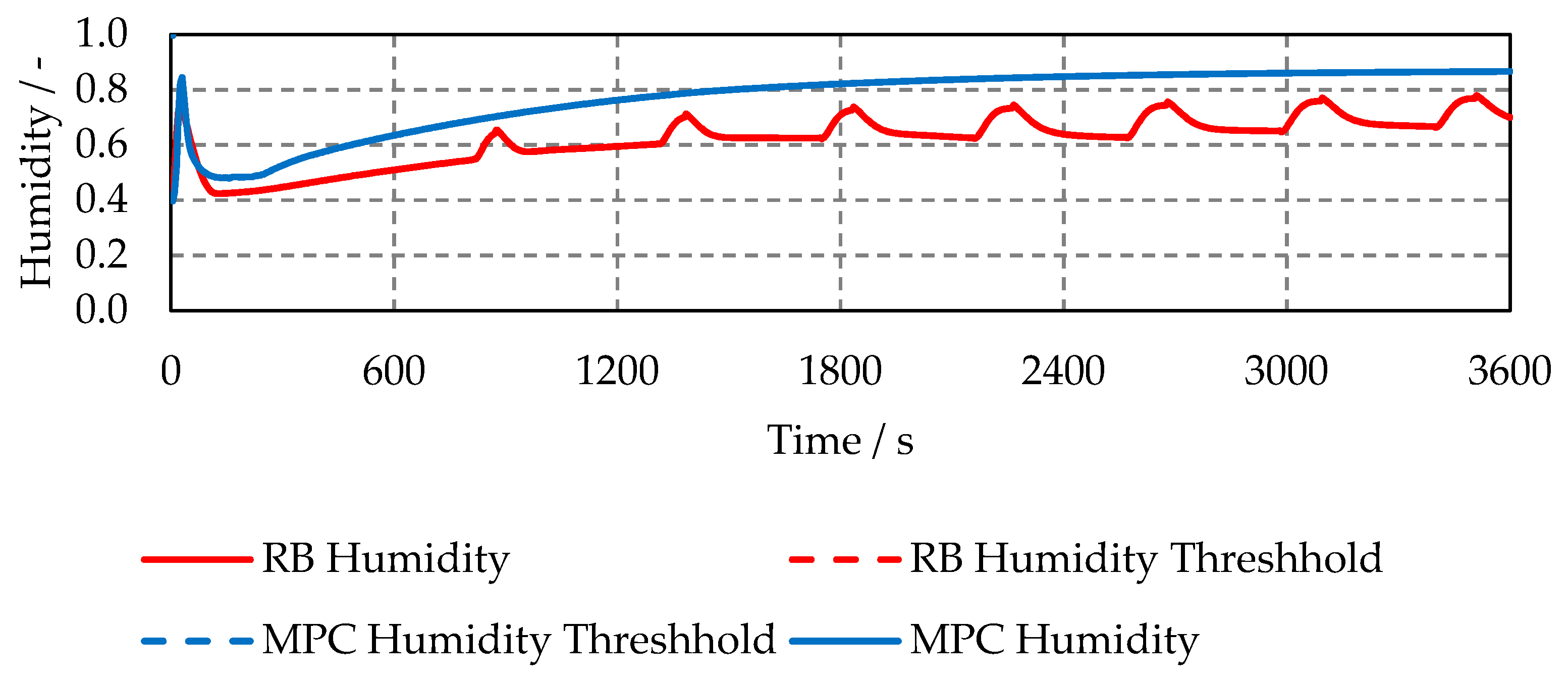
Disclaimer/Publisher’s Note: The statements, opinions and data contained in all publications are solely those of the individual author(s) and contributor(s) and not of MDPI and/or the editor(s). MDPI and/or the editor(s) disclaim responsibility for any injury to people or property resulting from any ideas, methods, instructions or products referred to in the content. |
© 2024 by the authors. Licensee MDPI, Basel, Switzerland. This article is an open access article distributed under the terms and conditions of the Creative Commons Attribution (CC BY) license (https://creativecommons.org/licenses/by/4.0/).
Share and Cite
Schutzeich, P.; Pischinger, S.; Hemkemeyer, D.; Franke, K.; Hamelbeck, P. A Predictive Cabin Conditioning Strategy for Battery Electric Vehicles. World Electr. Veh. J. 2024, 15, 224. https://doi.org/10.3390/wevj15060224
Schutzeich P, Pischinger S, Hemkemeyer D, Franke K, Hamelbeck P. A Predictive Cabin Conditioning Strategy for Battery Electric Vehicles. World Electric Vehicle Journal. 2024; 15(6):224. https://doi.org/10.3390/wevj15060224
Chicago/Turabian StyleSchutzeich, Patrick, Stefan Pischinger, David Hemkemeyer, Kai Franke, and Paul Hamelbeck. 2024. "A Predictive Cabin Conditioning Strategy for Battery Electric Vehicles" World Electric Vehicle Journal 15, no. 6: 224. https://doi.org/10.3390/wevj15060224
APA StyleSchutzeich, P., Pischinger, S., Hemkemeyer, D., Franke, K., & Hamelbeck, P. (2024). A Predictive Cabin Conditioning Strategy for Battery Electric Vehicles. World Electric Vehicle Journal, 15(6), 224. https://doi.org/10.3390/wevj15060224






